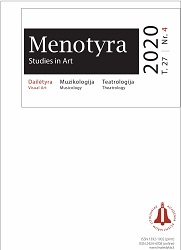Vieno Švč. Jėzaus Širdies paveikslo istorijos pėdsakais
Traces of the History of One Painting of the Sacred Heart of Jesus
Author(s): Regimanta StankevičienėSubject(s): History of Church(es), Visual Arts, Preservation, 18th Century, 19th Century, History of Art
Published by: Lietuvos mokslų akademijos leidykla
Keywords: painting “The Sacred Heart of Jesus”; the Eucharistic Sacred Heart of Jesus; church in Apytalaukis; Kazimierz and Ewa (of Uwoyni) Burba; Jan Rustem; Pietro Tedeschi; Lorenzo Capponi;
Summary/Abstract: Kazimierz and Ewa (of Uwoyni) Burba, the wojskis (officials attending to the needs of soldiers’ families during wars) of Šiauliai and collators of the Church of St Peter and St Paul in Apytalaukis, donated the painting “The Sacred Heart of Jesus” to the high altar of the church in 1817. From 1755, when a fraternity of the Sacred Heart of Jesus was established, this altar had been decorated with an earlier painting of the same name. The painting donated by the Burba decorated the first tier of a new high altar erected after 1817 and the existing high altar that was built before 1920s (?). It is believed that due to its poor condition, the old painting was replaced with a copy during repairs in 1964, and it is this copy that is on the altar to date. In 2019, the painting was restored as it had lost many fragments of the paint layer, especially at the bottom. The prototype of this painting is the painting “The Sacred Heart of Jesus and the Eucharist” by Pietro Tedeschi (the Church of the Blessed Virgin Mary of Mount Carmel, Imola, 1780). It is believed that the painter used an engraving of this image, presumably by Lorenzo Capponi. The painting in the church in Apytalaukis is narrower and therefore the baroque composition created by Pietro Tedeschi is somewhat reduced and adjusted. In addition, the drawing, rhythm, and colours of the painting of 1817 are characteristic of the features of the classicist style and paintings of the Vilnius School of Art. Due to the analogies of stylistics and the wellknown fact of Kazimierz Burba’s acquaintance with the painter Jan Rustem, the painting is hypothetically attributed to this artist. The face of Jesus in the painting in Apytalaukis can be compared to Burba’s portrait by Jan Rustem (unfortunately, only a copy has survived). We propose the title “The Eucharistic Sacred Heart of Jesus” as it defines the iconography of the painting more precisely.
Journal: Menotyra
- Issue Year: 27/2020
- Issue No: 4
- Page Range: 296-307
- Page Count: 12
- Language: Lithuanian

